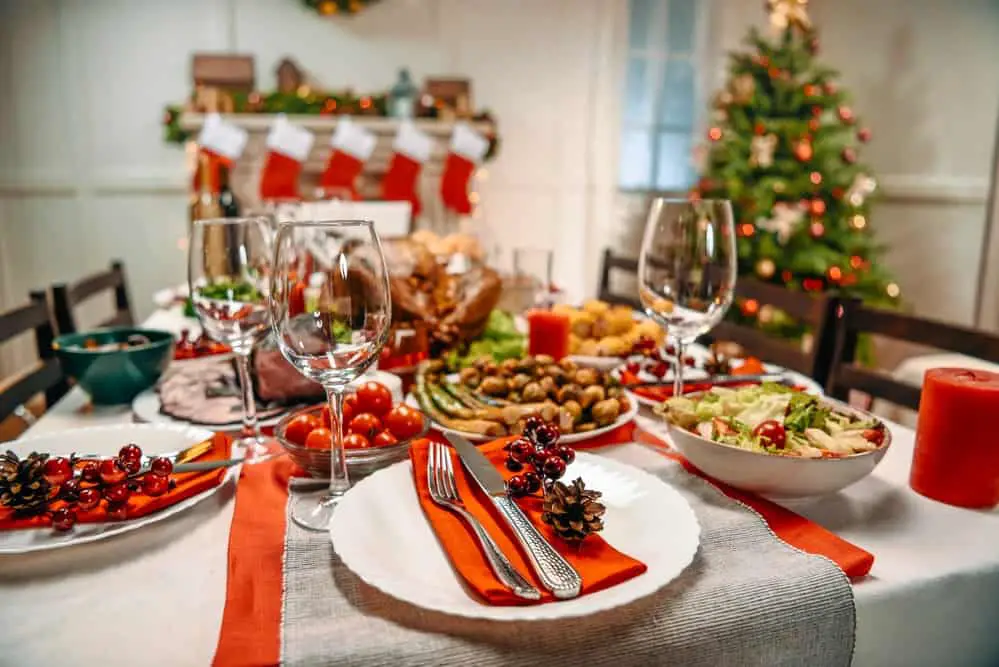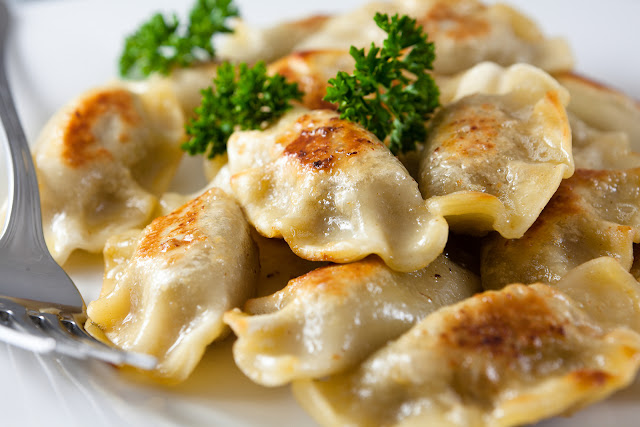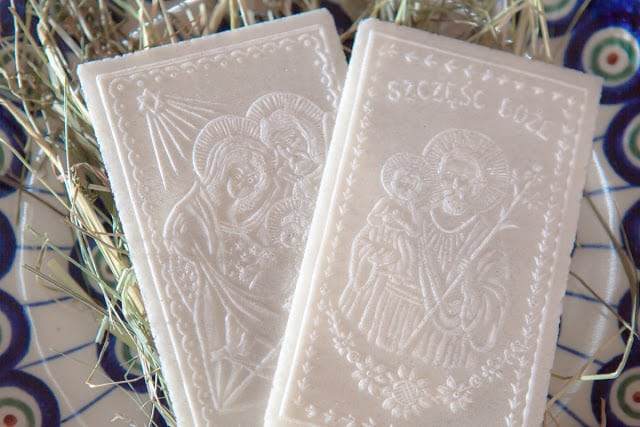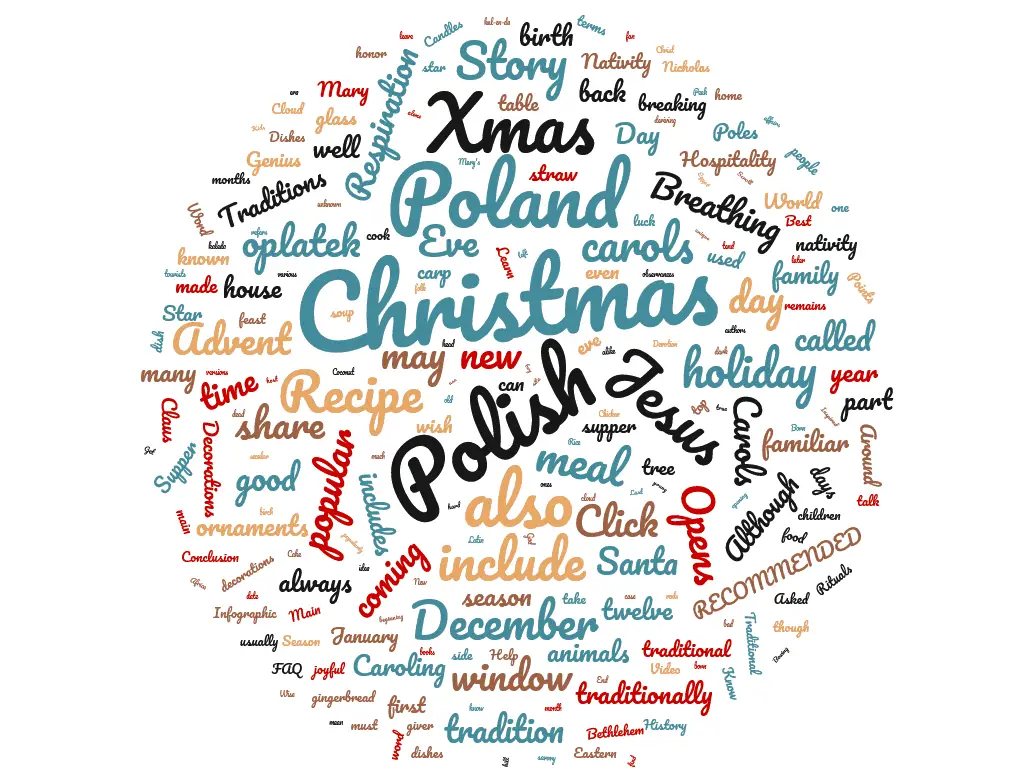The commercialization of Christmas has spread to many parts of the world.
But in Poland, a predominantly Catholic country, in which Poles take pride in their faith and folkways, Christmas remains spiritual, family-oriented, and joyful.
The Christmas Season
Advent
Reflecting the traditional Christian calendar, the Christmas season officially begins on the first of December 1, which is Advent.
Advent is the holiday that commemorates the annunciation of the coming birth of Jesus by the angel Gabriel to the Virgin Mary.
The advent season is devoted to getting into the true spirit of Christmas, and is rather Lent-like in its emphasis on self-sacrifice, and giving up favorite foods and entertainment.
Advent is also a time of literal housecleaning in anticipation of Christmas day, along with decorating the house for Christmas.
Christmas Decorations
Decorations may include spreading straw on the floor or under the table to commemorate the birth of Jesus in a manger.
The straw, or alternatively sheaves of wheat or barley, also may symbolize the wish for good fortune or a good harvest in the coming year.
Decoration, of course, includes putting up Christmas trees!
Masses and Nativity Scenes
Public religious activities include special masses commemorating the annunciation, known as the roraty.
Advent is also a time for performing nativity plays in school that can be fairly creative, and even contemporary in their interpretations of the Christmas story.
Public nativity scenes and displays are also popular and go back to the thirteenth century. This includes the tradition of the live, acted-out nativity scene that goes back to the Middle Ages.
The Polish word for Nativity scene, is szopka. The city of Krakow is particularly famous for its hand-carved szopki.
In recent times, the Krakow city government has sponsored a szopka competition, which takes place yearly on the first Thursday in December.
Christmas, called Wiligia (Veel-li-gee-ah) in Polish, which means vigil, is a major holiday that is observed nationwide.
Because it is a public holiday, government offices and businesses are closed, and trade is forbidden on the official holiday days.
These include December 24 (Christmas Eve), December 25 (Christmas Day), and December 26 (which is St. Stephen’s Day in Poland).
Even public transportation is limited during these festival days, so those who wish to travel within Poland during the Christmas season are advised to check schedules in advance.
Christmas Eve
Although Christmas in Poland is a joyful holiday, it also has a serious, penitential side. Part of getting into the spirit of Christmas in Poland involves fasting on December 24.
In addition, people avoid eating meat through the Christmas Eve supper, which is the main home observance of the Polish Christmas.
This meal, called in Polish, Kolacja Wiljilijina, is always eaten after dark when the first star appears,
During the hours leading up the meal, women cook, while children and men decorate the Christmas tree and set the table.
Christmas tree decorations in Poland always include a star on top, to represent the Star of Bethlehem.

Other decorations range from candles to glass ornaments to eggshell creations to gingerbread cookies.
Most ornaments are handmade or decorated, and the glass ornaments, called bombki, are the most popular and appear in many shapes.
In Eastern Poland, Christmas ornaments may be made of straw! Some Poles have the tradition of breaking a glass ornament, in order to frighten away any evil spirits for the coming year!
The Christmas tree customarily remains in the house through the twelve days of Christmas until January 6, on the feast of the Three Kings.
The Christmas Supper
The Christmas Eve meal always consists of twelve dishes, which stand for the twelve months of the year, in hopes for good luck in the coming twelve months.
The meal is traditionally meatless, in honor of the animals who were believed to have helped take care of baby Jesus.
Traditional Polish Christmas Dishes
Fish, however, is permitted, and the main dish of the meal is carp. Carp were traditionally bought live and kept in the family bathtub until it came time to kill and cook them.
Stories of kids not wanting the carp swimming in their bathtub to be killed are part of the holiday lore. Of course, nowadays, there is the option to simply buy and use carp filets.
The carp’s scales are said to bring good luck, which is why some Poles keep the leftover scales throughout the coming year, in their wallets!
Otherwise, the Christmas eve meal is strictly vegetarian.
Important dishes include borscht (beet soup) and pierogis (mushroom-stuffed mini-dumplings, as well as pancakes with mushrooms or cabbage.
 |
It is considered almost mandatory to eat borscht, but for those who really dislike it, there is also the option of savory mushroom soup.
Another Polish Christmas eve food tradition is braised sauerkraut–possibly an acquired taste for outsiders!
Meat may be served on Christmas day, so a popular Christmas day dish is bigos, which includes bacon as well as cabbage and sometimes dried plums.
The Polish Christmas menu also includes compote, made of apples and dried fruit, and herring served a variety of ways, including in cream sauce or with wine.
Polish Christmas desserts include kutia and piernik, the latter which is a gingerbread-like honey cake, as well as the more familiar gingerbread.
Although there is traditionally supposed to be no alcohol at a Christmas dinner, in practice, it depends on the family’s individual preferences.
Home-Based Christmas Rituals
Oplatek
Beyond strictly food, the central ritual of the Polish Christmas supper is the breaking of the oplatek, or Christmas wafer, made of plain flour and water.
Similar to the Communion host (commemorating the Last Supper), the oplatek is essentially an edible religious medallion, a wafer imprinted with the image of Jesus, Mary, and Joseph.
The oplatek is also scored for easy breaking when it is passed around so that each family member gets a piece.

Many also give pieces of the oplatek to their pets or farm animals.
This practice is based on the belief that animals who eat the oplatek will be able to talk at Christmas midnight, like the animals who witnessed the birth of Jesus.
During the passing of the oplatek, it is customary to express good wishes for one another.
Hospitality
It is also a custom in Polish homes during Christmas, to leave an empty place at the table, either to honor a dead or absent family member, or in case an unexpected guest should show up.
Hospitality is a very important part of the Polish Christmas supper, based on the idea that no one should celebrate the Christmas holiday alone.
Even tourists in who happen to be in Poland over Christmas Eve can find themselves invited! By contrast, Christmas day and the day after are much quieter and more private affairs.
Opening Presents
Christmas meals tend to be leisurely, which can be especially hard on children, in part because the meal must be finished before presents may be opened.
Sometimes adults may even purposefully delay the present opening with the singing of carols!
When presents are distributed, the accompanying cards are always left unsigned, to promote the belief in Santa Claus as the giver to young and old alike.
And all Christmas eve home observances must be wrapped up in time for the family to head to the Midnight Mass, popularly known as the “Shepherds Mass.”
Carols and Other Christmas Traditions
Carols and Caroling in Poland
Caroling and Christmas Carols are also very popular as part of a Polish Christmas. In Poland, carols are called kaleda (kal-en-da).
This term is deriving from the Latin word calendae, a term that refers to the beginning of the month.
There is a very strong folk tradition with Polish carols, and many have unknown authors.
Although some carols are simply Polish versions of familiar ones, such as “Silent Night,” many are unique to Poland, and some to various regions of Poland.
Nearly all are about the birth of Jesus, rather than the secular side of Christmas. Popular carols include Silent Night, as well as “God is born,” “Sleep Baby Jesus,” and “Jesus in Bethlehem.”
Although most of the popular Polish carols are from the baroque era, some date back to the Middle Ages.
Poland has produced more traditional carols than any other traditionally Christian nation in Europe.
Caroling is a group activity, and carolers sometimes even go from house to house in costume! People also go out caroling for Epiphany on January 6.
The Polish Santa and other Christmas Folklore
Santa Claus is a popular figure in a Polish Christmas, though he is a bit closer to the traditional St. Nicholas, whose feast day is celebrated on December 6, than the familiar red-suited figure.
He is nonetheless regarded as the present giver during the Christmas season, though in some Polish traditions, there are alternate figures, including the “Star Man” in Eastern Poland.
The Star Man is not an entirely benign figure–he is known to give bad kids birch rods, which are to be used for their punishment!
Other familiar Christmas customs in Poland include kissing under the mistletoe. All in all, Christmas in Poland is a time of joy, spirituality, and tradition.
In Polish Happy/Merry Christmas is called ‘Wesołych Świąt’. It is interesting to know how people wish Happy or Merry Christmas in other languages.
Learn More With the Help of Video
Main Points About Christmas in Poland
- On Christmas eve, Christmas trees are decorated by family members in the living room.
- It is customary for the polish families to leave a place setting for a lost wanderer who may need food or shelter.
- On Christmas eve, meat is not eaten and 12 dishes are made (symbolic of the 12 apostles).
- There is a lot of preparations before Christmas like a change of beddings, curtains, washing of windows and carpets.
- The smell of tangerine at schools or workplaces is symbolic that the festive time is here. Christmas time is a humble time in Poland. People give up their favorite food, drink, less partying and more church services, communions, and special masses.
Conclusion
The Polish celebration of Christmas is very similar to other countries in Eastern Europe, and ”Kolacja wigilijna”, or Christmas Eve Supper, is not to be eaten before the first star is seen in the sky.
The star should be a reminder of the star the Wisemen followed.
Some superstitious people in Poland believe that animals can talk at midnight on Christmas Eve, but so far no evidence of this!
Word Cloud for Christmas in Poland
The following is a collection of the most used terms in this article on Christmas in Poland. This should help in recalling related terms as used in this article at a later stage for you.




